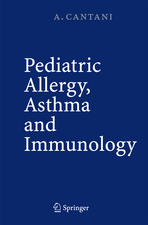Kawasaki Disease: Current Understanding of the Mechanism and Evidence-Based Treatment
Editat de Ben Tsutomu Saji, Jane W. Newburger, Jane C. Burns, Masato Takahashien Limba Engleză Hardback – 6 sep 2016
| Toate formatele și edițiile | Preț | Express |
|---|---|---|
| Paperback (1) | 888.28 lei 38-44 zile | |
| Springer – 14 iun 2018 | 888.28 lei 38-44 zile | |
| Hardback (1) | 1200.70 lei 38-44 zile | |
| Springer – 6 sep 2016 | 1200.70 lei 38-44 zile |
Preț: 1200.70 lei
Preț vechi: 1263.89 lei
-5% Nou
Puncte Express: 1801
Preț estimativ în valută:
229.78€ • 239.01$ • 189.70£
229.78€ • 239.01$ • 189.70£
Carte tipărită la comandă
Livrare economică 10-16 aprilie
Preluare comenzi: 021 569.72.76
Specificații
ISBN-13: 9784431560371
ISBN-10: 4431560378
Pagini: 554
Ilustrații: XIX, 552 p. 77 illus., 38 illus. in color.
Dimensiuni: 155 x 235 x 35 mm
Greutate: 1.24 kg
Ediția:1st ed. 2017
Editura: Springer
Colecția Springer
Locul publicării:Tokyo, Japan
ISBN-10: 4431560378
Pagini: 554
Ilustrații: XIX, 552 p. 77 illus., 38 illus. in color.
Dimensiuni: 155 x 235 x 35 mm
Greutate: 1.24 kg
Ediția:1st ed. 2017
Editura: Springer
Colecția Springer
Locul publicării:Tokyo, Japan
Cuprins
Part I: Basic Research.- 1 The History of Kawasaki Disease: A Personal Perspective.- 2 Histopathology of coronary arteritis in acute Kawasaki disease and murine systemic vasculitis induced by Candida albicans cell wall polysaccharide.- 3Histopathological characteristics aspects of organs other than the heart of noncardiac organs in Kawasaki disease.- 4 Identification of Novel Kawasaki Disease Susceptibility Genes by Genome-Wide Association Studies.- 5 Immunological Abnormalities and Use of Biomarkers and Cytokines to Predict the Severity of Kawasaki Disease.- 6 Pathophysiology of Kawasaki Disease.- 7 Update on Pathogenesis: Lessons Learned from Animal Models of Disease.- 8 The climate–KD link.- 9 Kawasaki Disease Shock Syndrome.- 10 Future directions in Kawasaki disease research.- Part II: Epidemiology.- 11 Epidemiologic Perspectives.- 12 Update on nationwide surveys and epidemiologic characteristics of Kawasaki disease in Japan.- 13 Kawasaki Disease Epidemiology in Europe.- 14 Recent topics in the epidemiology of Kawasaki disease.- Part III: Diagnosis and Examinations.- 15 Overview of Medical Treatment.- 16 Overview of the New Japanese Guideline2012 for the Medical Treatment of Acute Stage of Kawasaki Disease.- 17 Tumor Necrosis Factor-α Blockade for Treatment of Acute Kawasaki Disease.- 18 Methylprednisolone Pulse Therapy for Nonresponders to Immunoglobulin Therapy.- 19 Prednisolone.- 20 Cyclosporin A for IVIG nonresponders.- 21 Other challenging therapies.- 22 Antiplatelet and Antithrombotic Therapy for Giant Coronary Aneurysm.- 23 Characteristics of Sudden Cardiac Death Late After Acute Kawasaki Disease.- 24 Kawasaki disease diagnosis and complication rates in the United States and Japan.- 25 Mechanism of Action of Immunoglobulin: Sialylated IgG.- 26 Treatment Options for Refractory Kawasaki Disease: Alternative Treatments for Infliximab Nonresponders.- 27 Ulinastatin.- 28 Diagnosis and Management of Cardiovascular Risk Factors.- 29 Diagnosis and Characteristics of Typical and Incomplete Kawasaki Disease.- 30 Scoring systems to predict coronary artery lesions and nonresponse to initial intravenous immunoglobulin therapy.- 31 Use of magnetic resonance angiography for assessment of coronary artery lesions caused by Kawasaki disease.- 32 CT coronary and myocardial images in patients with coronary artery lesions.- 33 Long-Term Follow-up and Education Regarding Daily Life Activities, School Life, and Guidelines After Acute KD.- 34 Assessment of cardiac ischemia during acute and long-term follow-up and rheologic assessment of coronary artery lesions after Kawasaki disease.- 35 Promising biomarkers in acute Kawasaki disease and acute coronary ischemia.- 36 Coronary artery diameter Z score calculator.- 37 Evidence of endothelial damage in acute KD.- 38 Oxidative Stress in Kawasaki Disease.- Part V: Catheter Intervention and Surgery.- 39 Antiplatelet and anticoagulant therapies for Kawasaki disease: theory and practice.- 40 Guidelines for catheter intervention for coronary artery lesions in Kawasaki disease.- 41 Long-term Clinical Follow-up After Rotational Atherectomy for Coronary Arterial Stenosis in Kawasaki Disease.- 42 Long-term outcomes of pediatric coronary artery bypass grafting and downsizing for giant coronary aneurysms.- 43 Long-term outcomes of pediatric coronary artery bypass grafting and downsizing for giant coronary aneurysms.- Part VI: Follow-up Concerns.- 44 Functional and structural alterations of coronary arteries late after Kawasaki disease and the risk of acute coronary syndrome in adults.- 45 Psychosocial Effects of Kawasaki Disease and Transition to Adult Care.- 46 Kawasaki Disease: Road Map for the Future.- Appendix: Guidelines for diagnosis and management of cardiovascular sequelae in Kawasaki disease (JCS 2013).
Notă biografică
Dr. Ben Tsutomu Saji, First Department of Pediatrics, TohoUniversity Omori Medical Center, Tokyo, Japan.
Dr. Jane W. Newburger, Harvard Medical School, Department of Cardiology, Boston Children's Hospital, Boston, USA
Dr. Jane C. Burns, Department of Pediatrics, Rady Children’s Hospital, University of California San Diego School of Medicine, La Jolla, USA
Dr. Masato Takahashi, Heart Center, Seattle Children's Hospital, Seattle, USA
Dr. Jane W. Newburger, Harvard Medical School, Department of Cardiology, Boston Children's Hospital, Boston, USA
Dr. Jane C. Burns, Department of Pediatrics, Rady Children’s Hospital, University of California San Diego School of Medicine, La Jolla, USA
Dr. Masato Takahashi, Heart Center, Seattle Children's Hospital, Seattle, USA
Textul de pe ultima copertă
This book provides the most up-to-date information on the clinical research into and medical management of Kawasaki Disease, and opens the door for new pathological insights. Its nearly 50 sections cover basic research, genetic backgrounds, bacterial and biological evidence, and medical treatment with intravenous immunoglobulin, steroids, and recent anti-cytokine approaches. It offers an invaluable resource for general pediatricians, pediatric and adult cardiologists, pediatric cardiac surgeons, infectious disease specialists, pediatric rheumatologists, epidemiologists, and basic researchers in these disciplines.
Caracteristici
Covers all essential information for clinicians, including basic science and practical treatment
Discusses the latest advances using anti-cytokine therapies
Compiled by an international team of experts
Discusses the latest advances using anti-cytokine therapies
Compiled by an international team of experts










